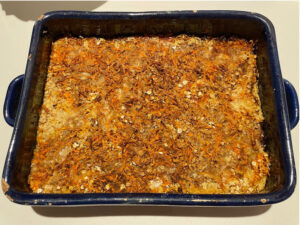Juliet Henderson
With a self-elected private nickname of ‘greedy grops’, you will understand I both love food and at times feel slightly guilty for how much this is so. However, my tendency to joyfully over-indulge at times is not the only aspect to my food practices. A third generation Quaker on my mother’s side, the Quaker testimonies of simplicity and sustainability along with the classical dictum of ‘a healthy mind in a healthy body’ structured what we ate as a family of six. The bulk of our food was grown by my father in the kitchen garden, then either eaten fresh, or bottled and frozen for winter. Other foods were also foraged to make soups, wine and more. Eggs came from the chickens in the stables. All that was purchased would be the healthy, organic option. This included 100% wholemeal bread so dry by the end the week we needed very sharp blades on the Kenwood bread cutter to slice it. We only very rarely ate meat. A sort of high days and feast days approach was taken to meat cooking, to honour my father’s own background. Sweets were not allowed, and reader, at times we children pined for soft, white, sliced bread or naughty biscuits. Luckily, we sometimes persuaded friends on school outings to share these with us.
I’m sure many of us from Quaker backgrounds, or similar, have stories of specific family food choices and eating practices premised on ethical community values that reflect an awareness of what makes the food on our supper plates possible – be that people, the environment, animals, energy consumption etc. All these embody the spirit of Quakerism in believing daily food choices are to be individually guided by the conscience and testimonies.

I would like to share the story and recipe of just one of the tasty dishes on our family table: Yowahafa. The unusual name of the dish comes from the phonetic pronunciations of the surnames of my mother and her sister and the three Quaker families who looked after them when they were evacuated to Saffron Walden during World War II. Namely, the Yeomans, Whitemans, Harrises and Fords. The dish is basically a mix of fried onions, grated carrots, oats, grated cheese, and marmite stock (or vegetable stock if preferred). For those wishing to give it a go, here are rough guidelines for preparing and cooking it that can be adapted to your preferences after a first try.
Ingredients: A standard supermarket pack of onions, 5 large organic carrots, rolled porridge oats, 250g grated cheddar, marmite or vegetable stock, salt and pepper
Cooking instructions: Gently fry onions in oil till golden brown and a bit crispy, then spread on bottom of cooking dish; grate carrots and spread on top of onions, season lightly; cover carrots with grated cheese; cover cheese with layer of porridge oats; season lightly with salt and pepper again. Make about 700ml of stock from marmite then pour over ingredients. Ensure there is enough stock for oats to soak up and soften. Gently push down top layer. Cook for approximately 30 minutes at 200°C.
| Previous Article | Next Article |
Back to October 2022 Newsletter Main Page
Forty-Three Newsletter • Number 522 • October 2022
Oxford Friends Meeting
43 St Giles, Oxford OX1 3LW
Copyright 2022, Oxford Quakers
